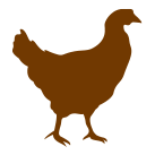Poultry Feed Formats
Choosing the right poultry feed format for your chooks
Pellets? Mash or crumbles? When it comes to choosing the right poultry feed format for your hens, it doesn’t have to be overwhelming. Learn more about each format here and which one might be best for your chooks.
Crumble feed
A crumble is feed that has been pelleted and then broken down into a smaller size for small beaks. As the process uses heat treatment, this increases the digestibility of nutrients for younger birds. Feeds such as the Barastoc Chick Starter and Pullet Grower are crumbles.
A crumble also helps to ensure that with each mouthful, chicks are getting the nutrients that they need. This means that they eat their feed faster and can’t selectively pick out the parts they like and leave the rest. This allows them to eat adequate levels of essential nutrients which are important for rapid growth. Studies have shown that young birds fed a crumbled feed eat more and grow faster than those fed a feed presented as a mash. The crumble form also ensures that the coccidiostat in the feed is eaten in adequate amounts to help keep chicks and pullets healthy.
When it comes to layer feed, what feed form you use is entirely up to you. It comes down to what you and your hens prefer as well as what suits the feeding system. There are advantages and disadvantages to each of the feed textures.
Pelleted feeds

Barastoc Golden Yolk, Champion Layer, Poultry Breeder and Mixed Flock are pelleted feeds. The pelleting process ensures ingredients can’t settle out of the feed so you know that your hen is getting all her key nutrients each day. It also makes the feed easy to pick up by the hen and eat what she needs during the day. This ensures that the hen has good feed intake to get her daily nutrient requirements and support good egg production. The heating process when making a pellet also increases the digestibility of the feed. You may also find that your chickens make less of a mess with pellets compared to mash.
Mash feeds

Mash feeds such as Barastoc Top Layer and Everyday Layer encourage the natural selection behaviour of the hen. It allows her to pick and choose what she would like to eat each day. It is also easy to see what is in the feed as the ingredients are physically visible and are easy to mix with other feeds. Because of the form, hens may be slower to eat their daily intake than what they would if given pellets. There may also be increased feed wastage from day to day as hens eat what they want and leave what they don’t behind.
It is important to have enough feeder space for your flock particularly with mash. This is because the dominant, bossy hens can eat all the large particles that they like and leave the rest for the smaller hens. This can lead to a variation in nutrient intake and body weight. Mash can also encourage wild birds to steal your hen’s food.

Barastoc Darling Downs contains a mixture of pellets along with a proportion of whole and cracked grains along with seeds. This is to encourage natural foraging behaviour and ensure the hens still get key minerals and vitamins in the form of a pellet. This ensures that the minerals and vitamins don’t separate and get left behind in the feeders.
If changing between forms of feed, always make sure that the new feed is mixed with the old feed and gradually phase the old feed out over 5-7 days. This ensures that the hen has time to adjust to the physical form of the new feed and means that you’ll have less feed wastage. Birds are highly driven by feed texture so abruptly changing the feed form can mean that they leave different parts of the feed behind.
It is always important to ensure that birds have access to clean fresh water on a daily basis as feed intake is driven by whether birds can drink or not.

